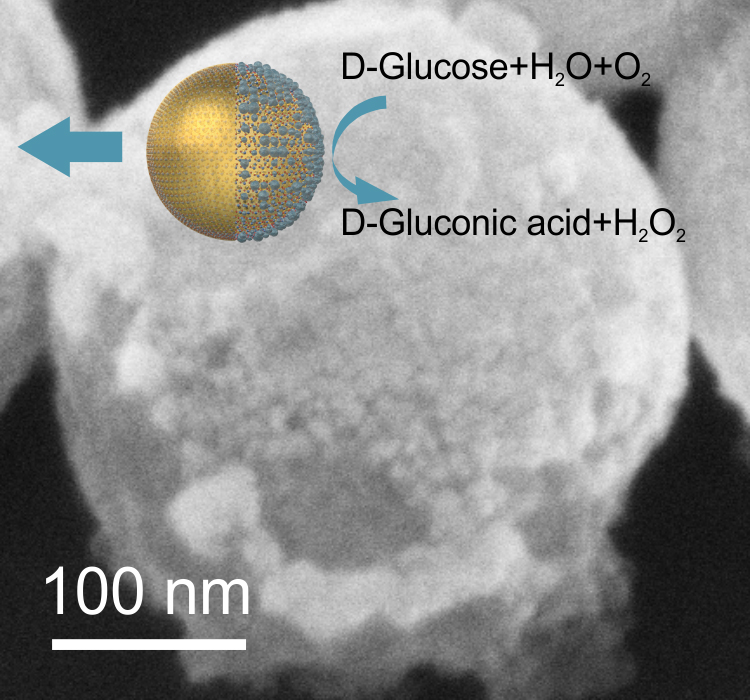Safe nanomotors propelled by sugar

An enzyme-powered nanomotor Dr. Samuel Sánchez
In a study published today in Nanoletters, Max Planck research group leader and ICREA research professor Samuel Sánchez and his collaborators at the University of Tübingen and the MPI for Solid State Research, Germany, describe their fabrication of the world’s first enzyme-powered synthetic nanomotors that overcome the disadvantages of current systems by being both biocompatible and powered by biologically benign fuels.
The new bio-friendly mini motors, which are made from hollow mesoporous silica proven to be harmless to cells and tissues, will be able to be used in biomedical applications, as their self-propulsion is powered by the biocatalytic reactions of three different naturally occurring enzymes: catalase, urease, and glucose oxidase. The enzymatic reactions power the Janus nanoparticles – special types whose surfaces have two or more distinct physical properties – by occurring asymmetrically on only one surface, propelling them in the opposite direction. Not only that, but the researchers based in Tübingen also broke new ground during this study by measuring, for the first time, the propulsion force of nanomotors using optical tweezers, leading to a better understanding of how self-propelled nanoparticles behave.
“To be safe for use in applications in medicine in the body, nanoparticles need to be made out of biocompatible and biodegradable materials, as well as being capable of both autonomous motion using biologically benign fuels and cargo delivery – such as drug delivery – at small scales,” says Samuel, who heads what has been described as ‘one of the leading groups in the field’ of nanomotor research, the Smart Nano-Bio-Devices group, with locations at the Max Planck Institute for Intelligent Systems (MPI-IS) in Stuttgart and at the Institute for Bioengineering of Catalonia (IBEC) in Barcelona. “We’ve tackled all these issues with our new particles. For their architecture, we used a material which offers a high drug-loading capacity owing to its hollow structure; and for propulsion, we based our methods on the quite recent discovery that enzymes by themselves can act as self-propelled nanomotors as well as being anchored to larger artificial objects, such as carbon nanotubes, to provide a propulsion force using catalytic reactions.”
Such biocatalytic reactions triggered by enzymes consume non-toxic ‘fuel’, as they are naturally present in a biological environment.Different enzyme/fuel combinations can also be used, such as catalase and hydrogen peroxide or glucose and glucose oxidase, meaning the method is very versatile with the potential to be extended to further enzymes.
Previous active micro-and nanosystems developed for potential biomedical uses – as carriers of drug molecules to targeted sites, for example – were limited when it came to real applications because their usual methods of propulsion, such as the decomposition of hydrogen peroxide and platinum, were short-lived and harsh; others were simply passive nanosystems, unable to move autonomously. Additionally, these nanomotors are for first time made up of non-metallic components but only made of silica and enzymes, which assures their biocompatibility and potential biodegradation .
The next steps for the researchers will be to explore how to increase the effective driving force and guide their bio-friendly nanomotors by external manipulation methods, such as chemotaxis, magnetic control or ultrasound, leading to directional movement for active drug delivery to specific locations.
The Max Planck Institute for Intelligent Systems with locations in Stuttgart and Tübingen emerged in 2011 from the Max Planck Institute for Metals Research in Stuttgart. In eight departments, scientists conduct research in the fields of materials science, computer science and biology.
Media Contact
All latest news from the category: Life Sciences and Chemistry
Articles and reports from the Life Sciences and chemistry area deal with applied and basic research into modern biology, chemistry and human medicine.
Valuable information can be found on a range of life sciences fields including bacteriology, biochemistry, bionics, bioinformatics, biophysics, biotechnology, genetics, geobotany, human biology, marine biology, microbiology, molecular biology, cellular biology, zoology, bioinorganic chemistry, microchemistry and environmental chemistry.
Newest articles

NASA: Mystery of life’s handedness deepens
The mystery of why life uses molecules with specific orientations has deepened with a NASA-funded discovery that RNA — a key molecule thought to have potentially held the instructions for…

What are the effects of historic lithium mining on water quality?
Study reveals low levels of common contaminants but high levels of other elements in waters associated with an abandoned lithium mine. Lithium ore and mining waste from a historic lithium…

Quantum-inspired design boosts efficiency of heat-to-electricity conversion
Rice engineers take unconventional route to improving thermophotovoltaic systems. Researchers at Rice University have found a new way to improve a key element of thermophotovoltaic (TPV) systems, which convert heat…



